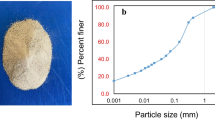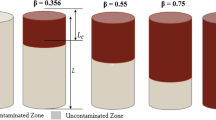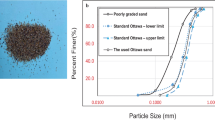Abstract
The characteristics of hydrocarbon-contaminated soils have been among major concerns of geotechnical engineers due to its significant frequency of event and also its influential consequences on our surroundings from various environmental and engineering viewpoints. Heretofore, the effects of diverse kinds of hydrocarbon contaminants on majority of geotechnical properties of fine- and coarse-grained soils such as grain size, hydraulic conductivity, plasticity, compressibility, internal friction, cohesion, and shear strength have been investigated. However, there has not been a concentrated research study examining shear wave velocity (\({\text{V}}_{\text{s}}\)) of hydrocarbon-contaminated soils as an important geotechnical property of soil due to this fact that, in small/very small strain levels, the maximum shear modulus of soils (\({\text{G}}_{ \hbox{max} }\)) can be determined using shear wave velocity (\({\text{G}}_{ \hbox{max} } =\uprho{\text{V}}_{\text{s}}^{2}\)). This paper aims to investigate effects of hydrocarbon contamination on shear wave velocity of sandy soils by comparing shear wave velocities in identically prepared clean and contaminated samples. To this aim, an Iranian light crude oil, a standard type of silica sand (Ottawa sand), and a bender element apparatus were used to minutely measure shear wave velocity of clean and crude oil contaminated sand samples. Moreover, dry and quasi-moist tamping methods were employed in order to provide comparable clean and contaminated specimens (containing 4, 6, 8, 10, and 12 wt% of crude oil), respectively. Firstly, a comprehensive bender element (BE) and resonant column tests were conducted on the identically prepared clean sand samples at various amounts of frequency (2–20 kHz) and under various confining pressure (50–500 kPa) to find the best methods of accurately determining shear wave travel time in BE tests. Thereafter, BE tests were conducted to examine shear wave velocity in contaminated specimens. Based on the results, it was found that there was a critical value for crude oil content with the maximum shear wave velocity so that shear wave velocity of 4 wt% contaminated sand (Vs-4 wt%) was about 1.2 times higher than clean one (Vs-clean), and contrastingly adding further crude oil up to 6 wt% made a significant reduction in value of shear wave velocity to some extent that Vs-6 wt% was slightly lower than Vs-clean (Vs-6 wt% = 0.95–0.97Vs-clean). Moreover, adding more contaminant (8–12 wt%) into sand had negligible influences on shear wave velocity. In this paper, the effects of crude oil contamination on sand microstructure were also evaluated using scanning electron microscopy.












Similar content being viewed by others
References
Aiban SA (1998) The long-term environmental effects of the Gulf War: the effect of temperature on the engineering properties of oil-contaminated sands. Environ Int 24:153–161. doi:10.1016/S0160-4120(97)00131-1
Akinwumi II, Diwa D, Obianigwe N (2014a) Effects of crude oil contamination on the index properties, strength and permeability of lateritic clay. Int J Appl Sci Eng Res 3:816–824
Akinwumi II, Maiyaki UR, Adubi SA, Daramola SO, Ekanem BB (2014b) Effects of waste engine oil contamination on the plasticity, strength and permeability of lateritic clay. Int J Sci Technol Res 3:331–335
Alhassan HM, Fagge SA (2013) Effects of crude oil, low point pour fuel oil and vacuum gas oil contamination on the geotechnical properties sand, clay and laterite soils. Int J Eng Res Appl 3:1947–1954
Al-Sanad HA, Ismael NF (1997) Aging effects on oil-contaminated Kuwaiti Sand. J Geotech Geoenviron Eng 123:290–293. doi:10.1061/(ASCE)1090-0241(1997)123:3(290)
Al-Sanad HA, Eid WK, Ismael NF (1995) Geotechnical properties of oil-contaminated Kuwaiti Sand. J Geotech Eng 121:407–412. doi:10.1061/(ASCE)0733-9410(1995)121:5(407)
Arroyo M, Wood DM, Greening PD, Medina L, Rio J (2006) Effects of sample size on bender-based axial G0 measurements. Géotechnique 56:39–52. doi:10.1680/geot.2006.56.1.39
Arulnathan R, Boulanger R, Riemer M (1998) Analysis of bender element tests. Geotech Test J 21:120–131. doi:10.1520/GTJ10750J
ASTM (2009) Standard Specification for Standard Sand vol C 778. ASTM International, West Conshohocken, PA, 2013
Brignoli E, Gotti M, Stokoe K (1996) Measurement of shear waves in laboratory specimens by means of piezoelectric transducers. Geotech Test J 19:384–397. doi:10.1520/GTJ10716J
Budhu M, Giese RF Jr, Campbell G, Baumgrass L (1991) The permeability of soils with organic fluids. Can Geotech J 28:140–147. doi:10.1139/t91-015
Cai Y, Dong Q, Wang J, Gu C, Xu C (2015) Measurement of small strain shear modulus of clean and natural sands in saturated condition using bender element test. Soil Dyn Earthq Eng 76:100–110. doi:10.1016/j.soildyn.2014.12.013
Castelli F, Cavallaro A, Grasso S, Lentini V (2016) Seismic microzoning from synthetic ground motion earthquake scenarios parameters: the case study of the city of Catania (Italy). Soil Dyn Earthq Eng 88:307–327. doi:10.1016/j.soildyn.2016.07.010
Cavallaro A, Ferraro A, Grasso S, Maugeri M (2012) Topographic effects on the Monte Po Hill in Catania (Italy). Soil Dyn Earthq Eng 43:97–113. doi:10.1016/j.soildyn.2012.07.022
Cavallaro A, Grasso S, Maugeri M, Motta E (2013a) An innovative low-cost SDMT marine investigation for the evaluation of the liquefaction potential in the Genova Harbour, Italy. In: Coutinho RQ, Mayne PW (eds) Geotechnical and geophysical site characterization 4. Taylor & Francis Group, London, pp 637–644
Cavallaro A, Grasso S, Maugeri M, Motta E (2013b) Site characterisation by in situ and laboratory tests of the sea bed in the Genova Harbour, Italy. In: Geotechnical and geophysical site characterization 4. CRC Press, Boca Raton, pp 415–422. doi:10.1201/b13251-44
Cook EE, Puri VK, Shin EC (1992) Geotechnical characteristics of crude oil-contaminated sands. In: Paper presented at the the second international offshore and polar engineering conference, San Francisco, California, USA
Di Matteo L, Bigotti F, Ricco R (2011) Compressibility of kaolinitic clay contaminated by ethanol-gasoline blends. J Geotech Geoenviron Eng 137:846–849. doi:10.1061/(ASCE)GT.1943-5606.0000494
Dyvik R, Madshus C (1986) Lab Measurements of Gmax Using Bender Element. In: Proceedings of ASCE convention on advances in the art of testing soils under cyclic conditions, pp 186–196
Estabragh AR, Beytolahpour I, Moradi M, Javadi AA (2016) Mechanical behavior of a clay soil contaminated with glycerol and ethanol. Eur J Environ Civ Eng 20:503–519. doi:10.1080/19648189.2015.1047900
Evgin E, Das BM (1992) Mechanical behavior of an oil contaminated sand. In: Acar. Ua (ed) Environmental geotechnology, proceedings of Mediterranean conference, Rotterdam. The Netherlands. Balkema Publishers, pp 101–108
Foreman DE, Daniel DE (1986) Permeation of compacted clay with organic chemicals. J Geotech Eng 112:669–681. doi:10.1061/(ASCE)0733-9410(1986)112:7(669)
Grasso S, Maugeri M (2014) Seismic microzonation studies for the city of Ragusa (Italy). Soil Dyn Earthq Eng 56:86–97. doi:10.1016/j.soildyn.2013.10.004
Gu X, Yang J, Huang M (2013) Laboratory measurements of small strain properties of dry sands by bender element. Soils Found 53:735–745. doi:10.1016/j.sandf.2013.08.011
Ijimdiya TS (2013) The effects of oil contamination on the consolidation properties of lateritic. Soil Dev Appl Ocean Eng (DAOE) 2:53–59
Jia YG, Wu Q, Meng X, Yang X, Yang Z, Zhang G (2010) Case study on influences of oil contamination on geotechnical properties of coastal sediments in the yellow river delta. In: Chen Y, Zhan L, Tang X (eds) Advances in Environmental geotechnics: proceedings of the international symposium on geoenvironmental engineering in Hangzhou, China, September 8–10, 2009. Springer, Heidelberg, pp 767–771. doi:10.1007/978-3-642-04460-1_94
Jovičić V, Coop MR, Simić M (1996) Objective criteria for determining Gmax from bender element tests. Géotechnique 46:357–362. doi:10.1680/geot.1996.46.2.357
Kawaguchi T, Mitachi T, Shibuya S (2001) Evaluation of shear wave travel time in laboratory by bender element test. In: Paper presented at the the fifteenth international conference on soil mechanics and geotechnical engineering, Istanbul
Kermani M, Ebadi T (2012) The effect of oil contamination on the geotechnical properties of fine-grained soils. Soil Sediment Contam Int J 21:655–671. doi:10.1080/15320383.2012.672486
Khamehchiyan M, Hossein Charkhabi A, Tajik M (2007) Effects of crude oil contamination on geotechnical properties of clayey and sandy soils. Eng Geol 89:220–229. doi:10.1016/j.enggeo.2006.10.009
Khosravi E, Ghasemzadeh H, Sabour MR, Yazdani H (2013) Geotechnical properties of gas oil-contaminated kaolinite. Eng Geol 166:11–16. doi:10.1016/j.enggeo.2013.08.004
Kumar J, Madhusudhan BN (2010) A note on the measurement of travel times using bender and extender elements. Soil Dyn Earthq Eng 30:630–634. doi:10.1016/j.soildyn.2010.02.003
Lee J-S, Santamarina JC (2005) Bender elements: performance and signal interpretation. J Geotech Geoenviron Eng 131:1063–1070. doi:10.1061/(ASCE)1090-0241(2005)131:9(1063)
Leong EC, Cahyadi J, Rahardjo H (2009) Measuring shear and compression wave velocities of soil using bender–extender elements. Can Geotech J 46:792–812. doi:10.1139/T09-026
Ling SY, Yong LC (2013) Behavior of piles in palm biodiesel contaminated mining sand. Int J Environ Sci 3:1822–1830
Mancuso C, Simonelli AL, Vinale F (1989) Numerical analysis of in situ S-wave measurements. In: Paper presented at the proc 12th international conference on soil mechanics and foundation engineering, Rio de Janeiro,
Maugeri M, Grasso S (2013) Liquefaction potential evaluation at Catania Harbour (Italy). In: Brebbia CA, Hernández S (eds) Earthquake resistant engineering structures IX, vol 132. WIT Press, WIT Transactions on The Built Environment, pp 69–82. doi:10.2495/ERES130061
Meegoda J, Rajapakse RA (1993) Short-term and long-term permeabilities of contaminated clays. J Environ Eng 119:725–743. doi:10.1061/(ASCE)0733-9372(1993)119:4(725)
Meegoda J, Ratnaweera P (1994) Compressibility of contaminated fine-grained soils. Geotech Test J 17:101–112. doi:10.1520/GTJ10078J
Mirsal IA (2004) Soil pollution origin, monitoring & remediation. Springer, Berlin
Murillo C, Sharifipour M, Caicedo B, Thorel LUC, Dano C (2011) Elastic parameters of intermediate soils based on bender-extender element pulse tests. Soils Found 51:637–649. doi:10.3208/sandf.51.637
Naeini SA, Shojaedin MM (2014) Effect of oil contamination on the liquefaction behavior of sandy soils. Int J Environ Chem Ecol Geol Geophys Eng 8:289–292
Nasr AMA (2013) Uplift behavior of vertical piles embedded in oil-contaminated sand. J Geotech Geoenviron Eng 139:162–174. doi:10.1061/(ASCE)GT.1943-5606.0000739
Nazir AK (2011) Effect of motor oil contamination on geotechnical properties of over consolidated clay. Alexandria Eng J 50:331–335. doi:10.1016/j.aej.2011.05.002
Ochepo J, Joseph V (2014) Effect of oil contamination on lime stabilized soil Jordan. J Civ Eng 8:88–96
Ola SA (1991) Geotechnical properties and behaviour of Nigerian tar sand. Eng Geol 30:325–336. doi:10.1016/0013-7952(91)90066-T
Onyelowe KC (2015) Pure crude oil contamination on Amaoba lateritic soil. Electron J Geotech Eng (EJGE) 20:1129–1142
Oyegbile OB, Ayininuola GM (2013) Laboratory studies on the influence of crude oil spillage on lateritic soil shear strength: a case study of Niger Delta Area of Nigeria. J Earth Sci Geotech Eng 3:73–83
Presti DCFL, Jamiolkowski M, Pallara O, Cavallaro A, Pedroni S (1997) Shear modulus and damping of soils. Géotechnique 47:603–617. doi:10.1680/geot.1997.47.3.603
Puri VK (2000) Geotechnical aspects of oil-contaminated sands. J Soil Contam 9:359–374. doi:10.1080/10588330091134301
Puri VK, Das BM, Cook EE, Shin EC (1994) Geotechnical properties of crude oil contaminated sand. Anal Soils Contam Petrol Const. doi:10.1520/STP12658S
Pusadkar SS, Bharambe PS (2014) Performance of petrol and diesel contaminated black cotton soil. Int J Eng Res Technol (IJERT) 3:536–539
Rahman H, Abduljauwad SN, Akram SN (2007) Geotechnical behavior of oil-contaminated fine-grained soils. Electron J Geotech Eng 12: Paper 0720. doi:http://www.ejge.com/2007/Ppr0720/Ppr0720.htm
Rahman ZA, Hamzah U, Ahmad N (2010a) Geotechnical characteristics of oil-contaminated granitic and metasedimentary soils asian. J Appl Sci 3:237–249. doi:10.3923/ajaps.2010.237.249
Rahman ZA, Hamzah U, Taha MR, Ithnain NS, Ahmad N (2010b) Influence of oil contamination on geotechnical properties of basaltic residual soil. Am J Appl Sci 7:8. doi:10.3844/ajassp.2010.954.961
Sanchez-Salinero I (1987) Analytical investigation of seismic methods used for engineering application. The University of Texas at Austin, Austin
Shin EC, Das BM (2001) Bearing capacity of unsaturated oil-contaminated sand. Int J Offshore Polar Eng 11:220–226
Shin EC, Lee JB, Das BM (1999) Bearing capacity of a model scale footing on crude oil-contaminated sand. Geotech Geol Eng 17:123–132. doi:10.1023/a:1016078420298
Shin EC, Omar MT, Tahmaz AA, Das BM (2002) Shear strength and hydraulic conductivity of oil-contaminated sand. In: L.G. de Mello MA (ed) Proceedings of the Fourth international congress on environmental geotechnics, Rio de Janeiro, Brazil. A.A. Balkema Publishers, Lisse, pp 9–13
Siang AJLM, Wijeyesekera DC, Yahya SMAS, Ramlan M (2014) Innovative testing investigations on the influence of particle morphology and oil contamination on the geotechnical properties of sand. Int J Integr Eng 6:60–66
Silvestri V, Mikhail N, Souli M (1997) Permeability response of oil-contaminated compacted clays vol STP1275. ASTM. doi:10.1520/STP1275-EB
Singh SK, Srivastava RK, John S (2008) Settlement characteristics of clayey soils contaminated with petroleum hydrocarbons. Soil Sediment Contam Int J 17:290–300. doi:10.1080/15320380802007028
Singh SK, Srivastava RK, John S (2009) Studies on soil contamination due to used motor oil and its remediation. Can Geotech J 46:1077–1083. doi:10.1139/T09-047
Solly G, Aswathy EA, Berlin S, Krishnaprabha NP, Maria G (2015) Study of geotechnical properties of diesel oil contaminated soil. Int J Civ Struct Eng Res 2:113–117
Srivastava RK, Pandey VD (1997) Geotechnical evaluation of oil contaminated soil. In: Sarsby RW (ed) the proceeding of CREEN 2 in the second international symposium on Geotechnics Related to the Environment Krakow, Poland. Thomas Telford, London
Talukdar DK, Saikia BD (2013) Effect of crude oil on some consolidation properties of clayey soil. Int J Emerg Technol Adv Eng 3:117–120
Tuncan A, Pamukcu S (1992) Geotechnical properties of petroleum and sludge contaminatd marine sediments. In: The second international offshore and polar engineering conference, San Francisco, USA. The International Society of Offshore and Polar Engineers, pp 14–19
Ukpong EC, Umoh IC (2015) Effects of ccrude oil spillage on geotecchnical propertiess of lateritic soil in Okoroete, eastern Obololo. Int J Eng Appl Sci 7:12–24
Uppot JO, Stephenson RW (1989) Permeability of clays under organic permeants. J Geotech Eng 115:115–131. doi:10.1061/(ASCE)0733-9410(1989)115:1(115)
Viggiani G, Atkinson JH (1995) Interpretation of bender element tests. Géotechnique 45:149–154. doi:10.1680/geot.1995.45.1.149
Walia BS, Singh G, Kaur M (2013) Study of diesel contaminated clayey soil. In: Paper presented at the proceedings of indian geotechnical conference, Roorkee, India, December 22–24
Yamashita S, Kawaguchi T, Nakata Y, Mikami T, Fujiwara T, Shibuya S (2009) Interpretation of international parallel test on the measurement of Gmax using bender elements. Soils Found 49:631–650. doi:10.3208/sandf.49.631
Acknowledgements
The authors wish to greatly acknowledge the beneficial supports in doing this research provided by West Oil and Gas Production Company (WOGPC) of Iran, Soil Mechanics Industry of Iran (SMI), and also International Institute of Earthquake Engineering and Seismology of Iran (IIEES).
Author information
Authors and Affiliations
Corresponding author
Rights and permissions
About this article
Cite this article
Rajabi, H., Sharifipour, M. An Experimental Characterization of Shear Wave Velocity (Vs) in Clean and Hydrocarbon-Contaminated Sand. Geotech Geol Eng 35, 2727–2745 (2017). https://doi.org/10.1007/s10706-017-0274-0
Received:
Accepted:
Published:
Issue Date:
DOI: https://doi.org/10.1007/s10706-017-0274-0




